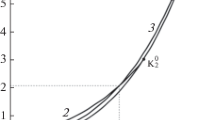Abstract
We have measured the critical light scattering intensity and the Rayleigh line shape for3He and for3He-4He mixtures with compositionX(3He)=0.95, 0.79, and 0.63 along their respective critical isochores near the plait point. The experimental linewidth of3He is compared with the calculated one from heat conductivity and equation of state measurements, and satisfactory agreement is obtained. For mixtures, gravity effects in our cell of finite height prevent us from reaching the critical point along a path at strictly constant composition and density. HenceT c cannot be determined directly. Using the prediction that the scattered light intensity in the mixtures has the same diverging behavior as for the pure fluid, we determine the reduced temperaturet≡[T − T c(X)]/T c from the intensity. The measured Rayleigh line shape can be expressed by a single decay rate Γ as a function oft for a given scattering angle of the light beam. Our experiments show that Γ in the mixtures is only weakly dependent on composition. Our analysis leads to the determination of the mass diffusion coefficientD, which is found to be nearly independent of composition and nearly equal to the thermal diffusivityD T measured for3He. The results are discussed in the light of the predictions from mode coupling theory.
Similar content being viewed by others
References
P. C. Hohenberg and B. J. Halperin,Rev. Mod. Phys. 49, 435 (1977).
H. L. Swinney and D. L. Henry,Phys. Rev. A 8, 2586 (1973).
H. C. Burstyn, J. V. Sengers, and P. Esfandiary,Phys. Rev. A 22, 282 (1980); H. C. Burstyn and J. V. Sengers,Phys. Rev. A 27, 1071 (1983) and references therein.
H. Guttinger and D. S. Cannell,Phys. Rev. A 22, 285 (1980) and references therein.
M. Giglio and A. Vendramini,Opt. Commun. 9, 80 (1973).
D. L. Henry, L. E. Evans, and R. Kobayashi,J. Chem. Phys. 66, 1802 (1977).
B. J. Ackerson and J. H. M. Hanley,J. Chem. Phys. 73, 3568 (1980).
R. F. Chang and T. Doiron, inProceedings of the 8th Symposium on Thermophysical Properties, J. V. Sengers, ed. (American Society of Mechanical Engineers, New York, 1982), Vol. 1, p. 458.
Y. Miura, H. Meyer, and A. Ikushima,Phys. Lett. 91, 309 (1982).
L. Mistura,Nuovo Cimento B 12, 35 (1972);J. Chem. Phys. 62, 4571 (1975).
H. McHugh and M. E. Paulaitis,J. Chem. Eng. Data 25, 326 (1980); Conference on Fluid Properties and Phase Equilibria for Chemical Process Design, Callaway Gardens, Georgia, April 10–15, 1983.
C. E. Pittman, L. H. Cohen, and H. Meyer,J. Low Temp. Phys. 46, 115 (1982).
L. H. Cohen, M. Dingus, and H. Meyer,J. Low Temp. Phys. 49, 545 (1982).
L. H. Cohen, M. Dingus, and H. Meyer,Phys. Rev. Lett. 50, 1058 (1983).
B. A. Wallace and H. Meyer,Phys. Rev. A 5, 953 (1972).
S. S. Leung and R. B. Griffiths,Phys. Rev. A 8, 2670 (1973).
G. R. Brown and H. Meyer,Phys. Rev. A 6, 1578 (1972).
T. Doiron, R. P. Behringer, and H. Meyer,J. Low Temp. Phys. 24, 345 (1976).
C. E. Pittman, T. Doiron, and H. Meyer,Phys. Rev. B 20, 3678 (1979).
L. D. Landau and E. M. Lifshitz,Fluid Mechanics (Addison-Wesley, 1959), Chapter VI.
C. Cohen, J. W. H. Sutherland, and J. M. Deutch,Physics and Chemistry of Liquids (Gordon and Breach, New York, 1971), Vol. 2, p. 213.
R. B. Griffiths and J. C. Wheeler,Phys. Rev. A 2, 1047 (1970).
M. A. Anisimov, A. V. Voronel, and E. E. Gorodetskii,Zh. Eksp. Fiz. 60, 1117 (1971);Sov. Phys. JETP 33, 606 (1971); see also M. A. Anisimov,Usp. Fiz. Nauk 114, 249 (1974).
L. P. Philippov,Int. J. Heat Mass Transfer 11, 331 (1968).
M. Giglio and Vendramini,Phys. Rev. Lett. 34, 561 (1975).
R. P. Behringer and H. Meyer,J. Low Temp. Phys. 46, 407, 435 (1982).
E. C. Kerr and R. H. Sherman,J. Low Temp. Phys. 19, 449 (1975).
M. E. Fisher,Rep. Prog. Phys. 30, 731 (1967).
J. V. Sengers and J. M. J. Van Leeuwen,Physica 116A, 345 (1982).
K. Ohbayashi,Jpn. J. Appl. Phys. 13, 1219 (1974).
K. Ohbayashi and A. Ikushima,J. Low Temp. Phys. 19, 449 (1975).
T. Doiron, private communication.
D. W. Oxtoby and G. Gelbart,J. Chem. Phys. 61, 2957 (1974).
R. F. Chang, J. M. H. Levelt Sengers, T. Doiron, and J. Jones, to be published.
L. H. Cohen, M. Dingus, and H. Meyer, to be published.
G. Ahlers, inThe Physics of Liquid and Solid Helium, Part I, K. H. Bennemann and J. B. Ketterson, eds. (Wiley, New York, 1976).
Author information
Authors and Affiliations
Rights and permissions
About this article
Cite this article
Miura, YI., Meyer, H. & Ikushima, A. The decay rate of critical fluctuations in3He-4He mixtures near the gas-liquid critical point. J Low Temp Phys 55, 247–271 (1984). https://doi.org/10.1007/BF00683445
Received:
Issue Date:
DOI: https://doi.org/10.1007/BF00683445




